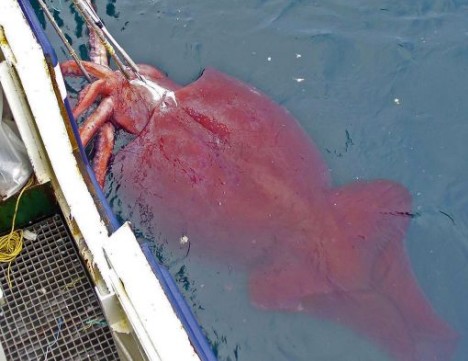Difference between revisions of "Template:Westarctica.wiki:Today's featured article"
Westarctica (talk | contribs) |
Westarctica (talk | contribs) |
||
| Line 1: | Line 1: | ||
[[File: | [[File:Colossal-Squid.jpg|thumb|300px|left]] | ||
'''[[ | The '''[[colossal squid]]''', sometimes called the [[Antarctic]] squid, is believed to be the largest squid species in terms of mass. It is known from only a few specimens, and current estimates put its maximum size at 12–14 m (39–46 ft) long and weighing possibly up to 750 kg (1,650 lb), based on analysis of smaller and immature specimens, making it the largest known invertebrate. | ||
The largest recorded specimen was captured in 2007 by a New Zealand fishing boat off [[Antarctica]]. It was initially estimated to measure 4.5 m (15 ft) in length and weigh 450 kg (990 lb). The squid was taken back to New Zealand for scientific study. A study on the specimen later showed its actual weight was 495 kg (1,091 lb), but it only measured 4.2 m (14 ft) in total length as a result of the tentacles' shrinking post mortem. | |||
'''([[ | '''([[colossal squid|Full Article...]])''' | ||
Revision as of 06:03, 10 September 2018
The colossal squid, sometimes called the Antarctic squid, is believed to be the largest squid species in terms of mass. It is known from only a few specimens, and current estimates put its maximum size at 12–14 m (39–46 ft) long and weighing possibly up to 750 kg (1,650 lb), based on analysis of smaller and immature specimens, making it the largest known invertebrate.
The largest recorded specimen was captured in 2007 by a New Zealand fishing boat off Antarctica. It was initially estimated to measure 4.5 m (15 ft) in length and weigh 450 kg (990 lb). The squid was taken back to New Zealand for scientific study. A study on the specimen later showed its actual weight was 495 kg (1,091 lb), but it only measured 4.2 m (14 ft) in total length as a result of the tentacles' shrinking post mortem.
